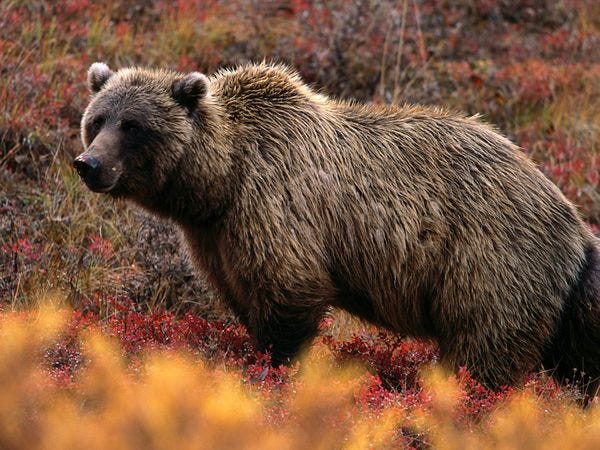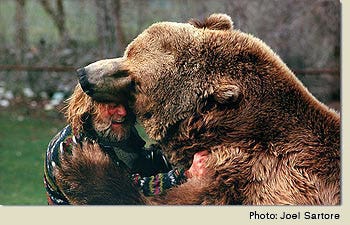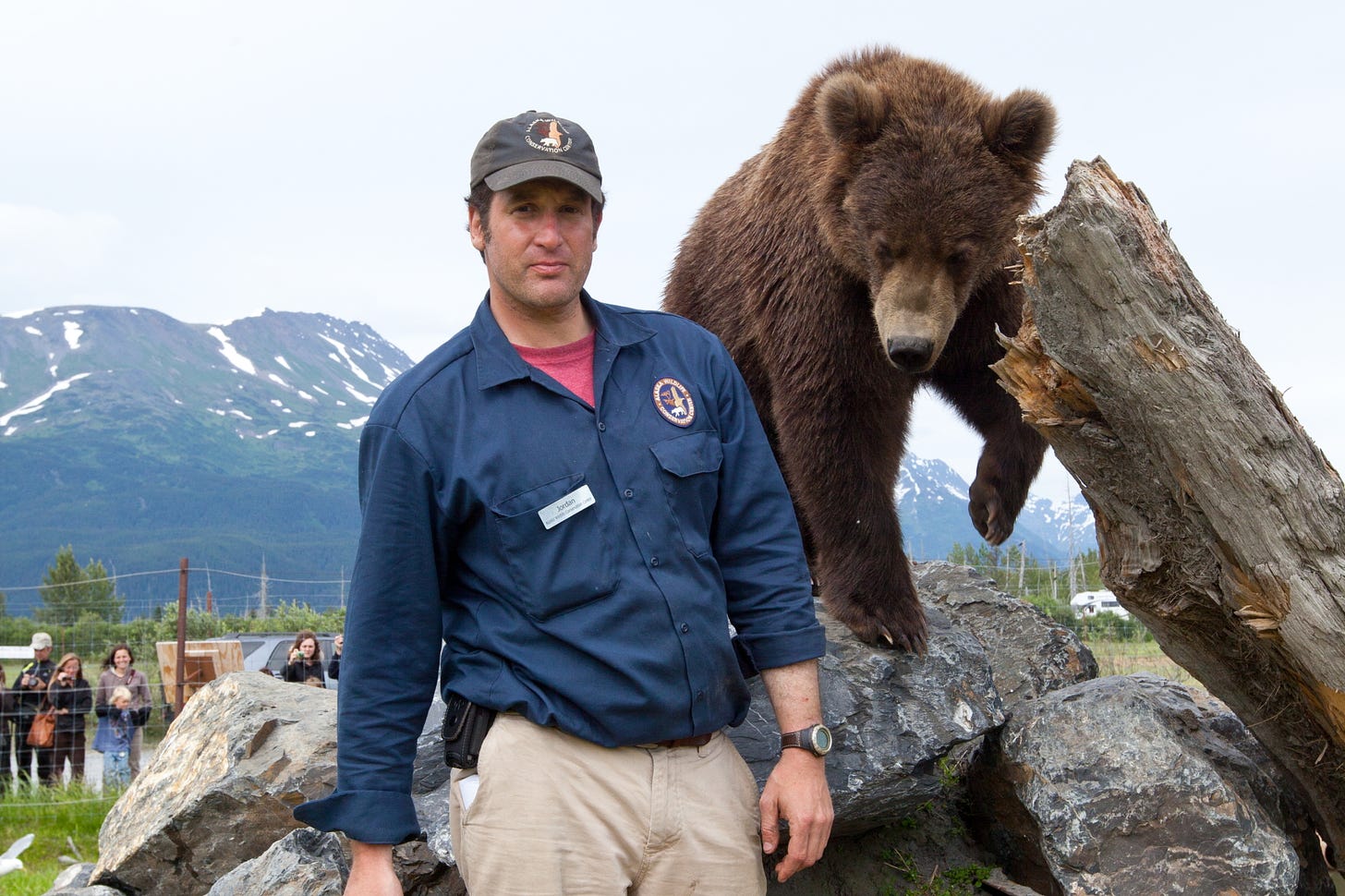Vital Ground Protects Grizzly Bear Habitat Throughout their North American Range
By Jordan Schaul | National Geographic | September 25, 2013
Vital Ground is a Montana-based land trust dedicated to protecting grizzly bear habitat in North America.
The organization supports bear conservation ecology studies in 6 ecosystems, which are scattered throughout Alaska, the Lower 48 (Montana, Idaho, and Wyoming) and in Canada.
According to the organization’s newly revamped website, the land trust has “helped protect and enhance nearly 600,000 acres of crucial wildlife habitat in Montana, Idaho, Wyoming, Alaska, and British Columbia” since the inception of the organization in 1990.
Just recently, Vital Ground contributed several thousand dollars to a USGS hair-sampling study currently underway to estimate the number of grizzly bears inhabiting the 2.4 million acres Cabinet-Yaak Ecosystem.
The bear population being studied in the Yaak River Drainage Basin area by the USGS scientists is in danger and could vanish altogether. The population is suspected to be extremely small with as few as 30 to 40 bears in two disconnected subpopulations. In other words, the grizzly bear population in the region is barely hanging on.
The mountainous 6,690 square km Cabinet-Yaak Ecosystem and the 3,185 square km surrounding area is the U.S. Fish and Wildlife Service’s designated grizzly bear recovery area in the transboundary region of British Columbia and Northwestern Montana. It has long been occupied by grizzly bears, which are usually considered umbrella species in the various landscapes that they continue to call home.
The USGS study, launched in 2012, required a setup crew of 70 people and has involved monitoring bear hair-snagging stations across the Cabinet-Yaak Ecosystem’s Cabinet mountain range of northwest Montana and northern Idaho—a mountain range contiguous with British Columbia’s Purcell mountains. The Cabinet-Purcell mountain range offers core habitat for grizzly bears.
Famed animal trainer Doug Seus and wife Lynne of the Wasatch Rocky Mountain Wildlife, Inc. founded Vital Ground as a way to give back to their beloved Bart the Bear, perhaps the greatest bear ambassador to have ever lived and a heck of a sensation in feature films.
The Seuses realized that through their work with Bart, they could best help save grizzly bears by protecting grizzly habitat. They purchased 240 acres of land in Montana’s Rocky Mountains—a piece of prime grizzly bear habitat that adjoins Pine Butte Preserve, a protected area in the state.
According to the Vital Ground website, “The goal is to protect habitats in a way that will allow grizzly populations living in the lower 48 states to connect with more robust populations in southern portions of Alberta and British Columbia. This would ultimately give grizzlies access to the northern end of the Selway-Bitterroot ecosystem, the largest wildland complex south of Canada, which is currently unoccupied by grizzlies.”
The Seuses continue to work with captive animal ambassadors, and a new generation of grizzly bears have followed in Bart’s footsteps, entertaining and educating the masses about grizzly bears. In the meantime, Vital Ground will serve as a land trust protecting habitat for bears and other North American wildlife for years to come.
ABOUT THE AUTHOR
ABOUT NATIONAL GEOGRAPHIC SOCIETY
The National Geographic Society is a global nonprofit organization that uses the power of science, exploration, education and storytelling to illuminate and protect the wonder of our world. Since 1888, National Geographic has pushed the boundaries of exploration, investing in bold people and transformative ideas, providing more than 14,000 grants for work across all seven continents, reaching 3 million students each year through education offerings, and engaging audiences around the globe through signature experiences, stories and content. To learn more, visit www.nationalgeographic.org or follow us on Instagram, Twitter and Facebook.
MEET THE AUTHOR
With training in wildlife ecology, conservation medicine and comparative psychology, Dr. Schaul's contributions to Nat Geo Voices have covered a range of environmental and social topics. He draws particular attention to the plight of imperiled species highlighting issues at the juncture or nexus of sorta situ wildlife conservation and applied animal welfare. Sorta situ conservation practices are comprised of scientific management and stewardship of animal populations ex situ (in captivity / 'in human care') and in situ (free-ranging / 'in nature'). He also has a background in behavior management and training of companion animals and captive wildlife and conservation marketing and digital publicity. Jordan has shared interviews with colleagues and public figures, as well as editorial news content. In addition, he has posted narratives describing his own work, which include the following examples: • Restoration of wood bison to the Interior of Alaska while (As Animal Curator at Alaska Wildlife Conservation Center and courtesy professor at the University of Alaska) • Rehabilitation of orphaned sloth bears exploited for tourists in South Asia (As executive consultant 'in-residence' at the Agra Bear Rescue Center managed by Wildlife SOS) • Censusing small wild cat (e.g. ocelot and margay) populations in the montane cloud forests of Costa Rica for popular publications with 'The Cat Whisperer' Mieshelle Nagelschneider • Evaluating the impact of ecotourism on marine mammal population stability and welfare off the coast of Mexico's Sea of Cortez (With Boston University's marine science program) Jordan was a director on boards of non-profit wildlife conservation organizations serving nations in Africa, North and South America and Southeast Asia. He is also a consultant to a human-wildlife conflict mitigation organization in the Pacific Northwest. Following animal curatorships in Alaska and California, he served as a charter board member of a zoo advocacy and outreach organization and later as its executive director. Jordan was a member of the Communication and Education Commission of the International Union for the Conservation of Nature (CEC-IUCN) and the Bear Specialist Group of the IUCN Species Survival Commission (BSG-SSC-IUCN). He has served on the advisory council of the National Wildlife Humane Society and in service to the Bear Taxon Advisory Group of the Association of Zoos and Aquariums (AZA Bear TAG). In addition, he was an ex officio member of the council of the International Association for Bear Research and Management.






